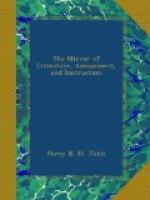The protection of buildings from the effects of lightning, is the most important practical application of the theory of electricity. Conductors for this should be formed of metallic rods, pointed at the upper extremity, and placed so as to project a few feet above the highest part of the building they are intended to secure; they should be continued without interruption till they descend into the ground, below the foundation of the house. Copper is preferable to iron as the material for their construction, being less liable to destruction by rust, or by fusion, and possessing also a greater conducting power. The size of the rods should be from half an inch to an inch in diameter, and the point should be gilt, or made of platina, that it may be more effectually preserved from corrosion. An important condition in the protecting conductor is, that no interruption should exist in its continuity from top to bottom; and advantage will result from connecting together by strips of metal all the leaden water pipes, or other considerable masses of metal in or about the building, so as to form one continuous system of conductors, for carrying the electricity by different channels to the ground. The lower end of the conductors should be carried down into the earth till it reaches either water, or at least a moist stratum.—Library of Useful Knowledge.
* * * * *
The Sketch-Book.
THE MYSTERIOUS TAILOR.
A Romance of High Holborn.
It came to pass that, towards the close of 1826, I found occasion to change my tailor, and by chance, or the recommendation of friends—I cannot now remember which—applied to one who vegetated in that particular region of the metropolis where the rivers of Museum-street and Drury-lane (to adopt the language of metaphor) flow into and form the capacious estuary of High Holborn. Whoever has sailed along, or cast anchor in this confluence, must have seen the individual I allude to. He sits—I should perhaps say sat, inasmuch as he is since defunct—bolt upright, with a pen behind his ear, in the centre of a dingy, spectral-looking shop, quaintly hung round with clothes, of divers forms and patterns, in every stage of existence—from the first crude conception of the incipient surtout or pantaloons, down to the last glorious touch that immortalizes the artist. His figure is slim and undersized; his cheeks are sallow, with two furrows on each side his nose, filled not unfrequently with snuff; his eyes project like lobsters’, and cast their shifting glances about with a vague sort of mysterious intelligence; and his voice—his startling, solemn, unearthly voice—seems hoarse with sepulchral vapours, and puts forth its tones like the sighing of the wind among tombs. With regard to his dress, it is in admirable keeping with his countenance. He wears a black coat, fashioned in the mould of other times, with large cloth buttons and flowing skirts; drab




